The Role of Blockchain in International Trade Finance: A Study
VerifiedAdded on 2020/10/22
|61
|21211
|165
Project
AI Summary
This project delves into the transformative potential of blockchain technology within the realm of international trade finance. It explores how blockchain can revolutionize trade finance, customs procedures, and the provenance of goods. The research examines how blockchain can reduce costs and time, enhance security, and boost trade volumes. The study employs a pluralist approach, combining literature analysis, interviews with industry experts, and theoretical interpretations based on transaction cost and cross-border trade finance theories. Key findings suggest that while blockchain-based systems currently lack enterprise maturity, the technology can significantly digitize and automate trade finance processes, reducing turnaround times, eliminating paper-based processes, and enabling faster settlements. Furthermore, it highlights the potential of blockchain to disrupt traditional financial services through smart contracts and distributed ledgers, ultimately improving efficiency and transparency in global trade. The project also addresses the research gap by providing insights into the practical application of blockchain in trade finance and suggests future directions for researchers, developers, regulators, and businesses interested in leveraging this technology.
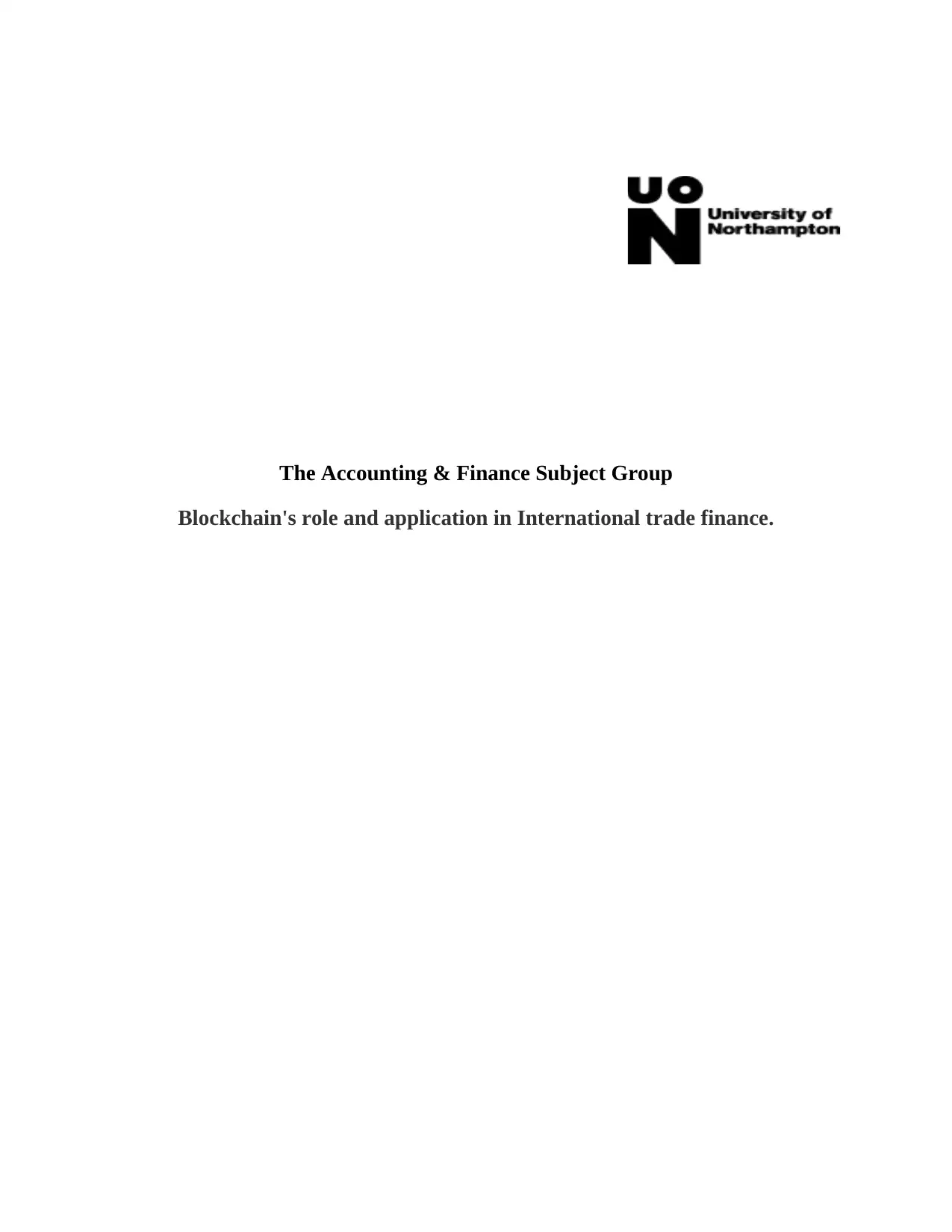
The Accounting & Finance Subject Group
Blockchain's role and application in International trade finance.
Blockchain's role and application in International trade finance.
Paraphrase This Document
Need a fresh take? Get an instant paraphrase of this document with our AI Paraphraser
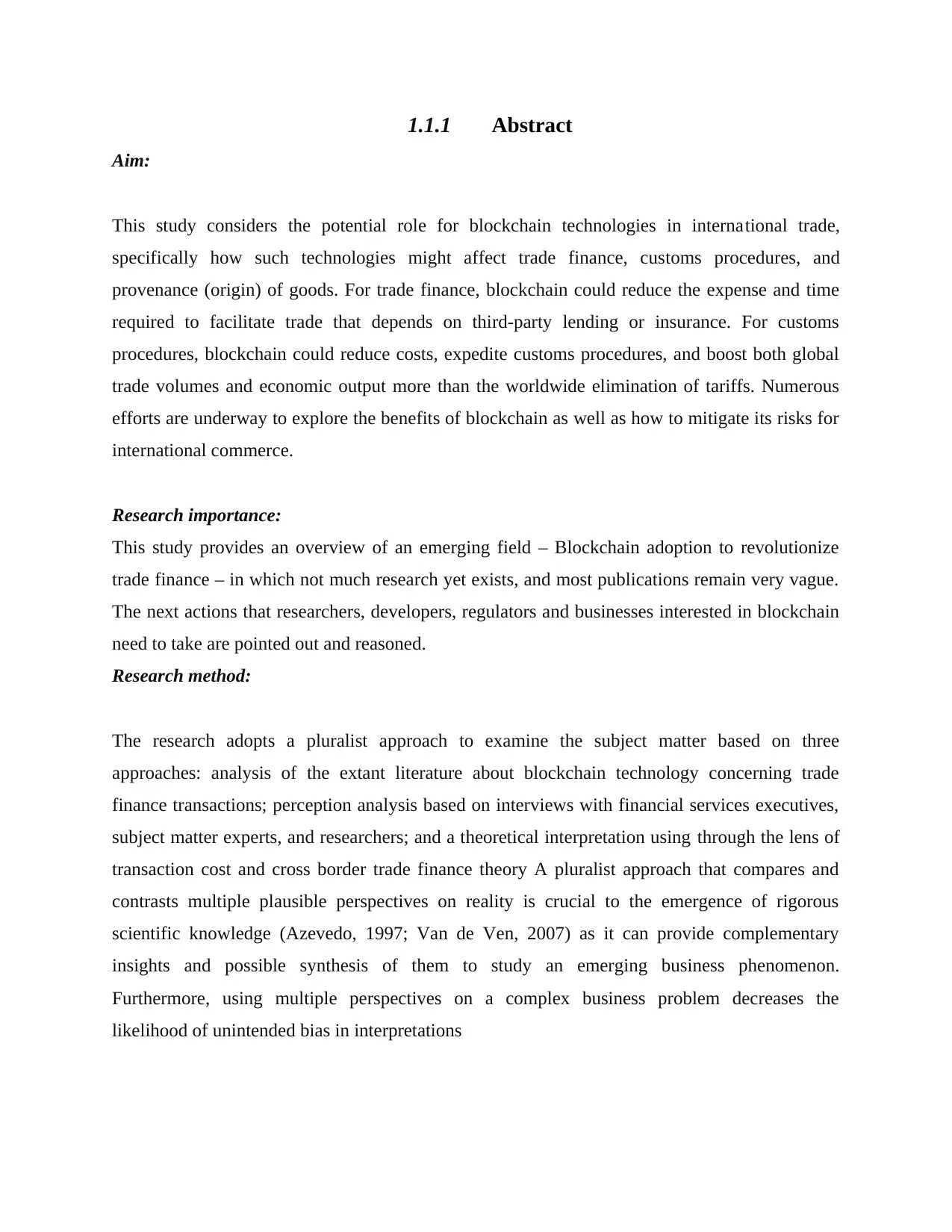
1.1.1 Abstract
Aim:
This study considers the potential role for blockchain technologies in international trade,
specifically how such technologies might affect trade finance, customs procedures, and
provenance (origin) of goods. For trade finance, blockchain could reduce the expense and time
required to facilitate trade that depends on third-party lending or insurance. For customs
procedures, blockchain could reduce costs, expedite customs procedures, and boost both global
trade volumes and economic output more than the worldwide elimination of tariffs. Numerous
efforts are underway to explore the benefits of blockchain as well as how to mitigate its risks for
international commerce.
Research importance:
This study provides an overview of an emerging field – Blockchain adoption to revolutionize
trade finance – in which not much research yet exists, and most publications remain very vague.
The next actions that researchers, developers, regulators and businesses interested in blockchain
need to take are pointed out and reasoned.
Research method:
The research adopts a pluralist approach to examine the subject matter based on three
approaches: analysis of the extant literature about blockchain technology concerning trade
finance transactions; perception analysis based on interviews with financial services executives,
subject matter experts, and researchers; and a theoretical interpretation using through the lens of
transaction cost and cross border trade finance theory A pluralist approach that compares and
contrasts multiple plausible perspectives on reality is crucial to the emergence of rigorous
scientific knowledge (Azevedo, 1997; Van de Ven, 2007) as it can provide complementary
insights and possible synthesis of them to study an emerging business phenomenon.
Furthermore, using multiple perspectives on a complex business problem decreases the
likelihood of unintended bias in interpretations
Aim:
This study considers the potential role for blockchain technologies in international trade,
specifically how such technologies might affect trade finance, customs procedures, and
provenance (origin) of goods. For trade finance, blockchain could reduce the expense and time
required to facilitate trade that depends on third-party lending or insurance. For customs
procedures, blockchain could reduce costs, expedite customs procedures, and boost both global
trade volumes and economic output more than the worldwide elimination of tariffs. Numerous
efforts are underway to explore the benefits of blockchain as well as how to mitigate its risks for
international commerce.
Research importance:
This study provides an overview of an emerging field – Blockchain adoption to revolutionize
trade finance – in which not much research yet exists, and most publications remain very vague.
The next actions that researchers, developers, regulators and businesses interested in blockchain
need to take are pointed out and reasoned.
Research method:
The research adopts a pluralist approach to examine the subject matter based on three
approaches: analysis of the extant literature about blockchain technology concerning trade
finance transactions; perception analysis based on interviews with financial services executives,
subject matter experts, and researchers; and a theoretical interpretation using through the lens of
transaction cost and cross border trade finance theory A pluralist approach that compares and
contrasts multiple plausible perspectives on reality is crucial to the emergence of rigorous
scientific knowledge (Azevedo, 1997; Van de Ven, 2007) as it can provide complementary
insights and possible synthesis of them to study an emerging business phenomenon.
Furthermore, using multiple perspectives on a complex business problem decreases the
likelihood of unintended bias in interpretations
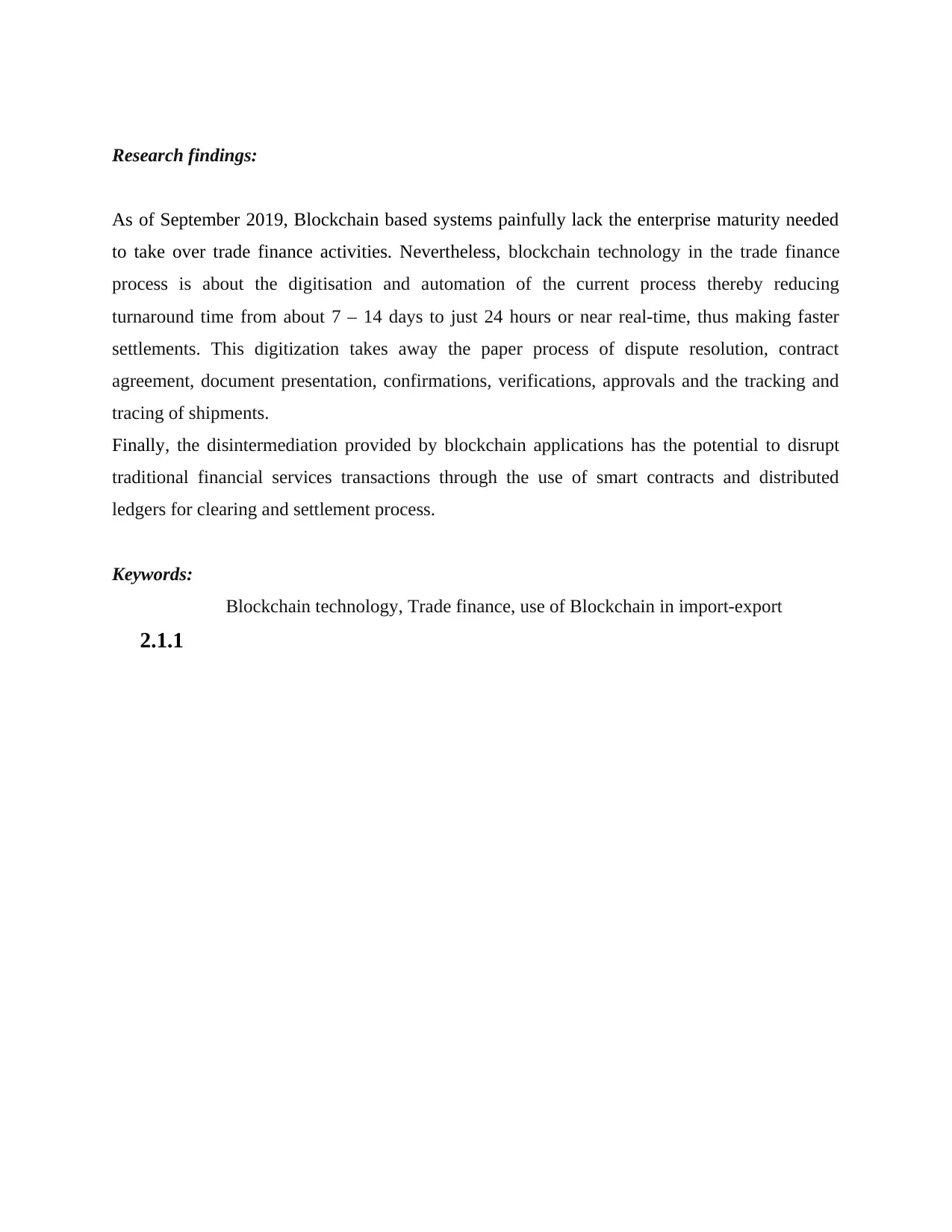
Research findings:
As of September 2019, Blockchain based systems painfully lack the enterprise maturity needed
to take over trade finance activities. Nevertheless, blockchain technology in the trade finance
process is about the digitisation and automation of the current process thereby reducing
turnaround time from about 7 – 14 days to just 24 hours or near real-time, thus making faster
settlements. This digitization takes away the paper process of dispute resolution, contract
agreement, document presentation, confirmations, verifications, approvals and the tracking and
tracing of shipments.
Finally, the disintermediation provided by blockchain applications has the potential to disrupt
traditional financial services transactions through the use of smart contracts and distributed
ledgers for clearing and settlement process.
Keywords:
Blockchain technology, Trade finance, use of Blockchain in import-export
2.1.1
As of September 2019, Blockchain based systems painfully lack the enterprise maturity needed
to take over trade finance activities. Nevertheless, blockchain technology in the trade finance
process is about the digitisation and automation of the current process thereby reducing
turnaround time from about 7 – 14 days to just 24 hours or near real-time, thus making faster
settlements. This digitization takes away the paper process of dispute resolution, contract
agreement, document presentation, confirmations, verifications, approvals and the tracking and
tracing of shipments.
Finally, the disintermediation provided by blockchain applications has the potential to disrupt
traditional financial services transactions through the use of smart contracts and distributed
ledgers for clearing and settlement process.
Keywords:
Blockchain technology, Trade finance, use of Blockchain in import-export
2.1.1
⊘ This is a preview!⊘
Do you want full access?
Subscribe today to unlock all pages.

Trusted by 1+ million students worldwide
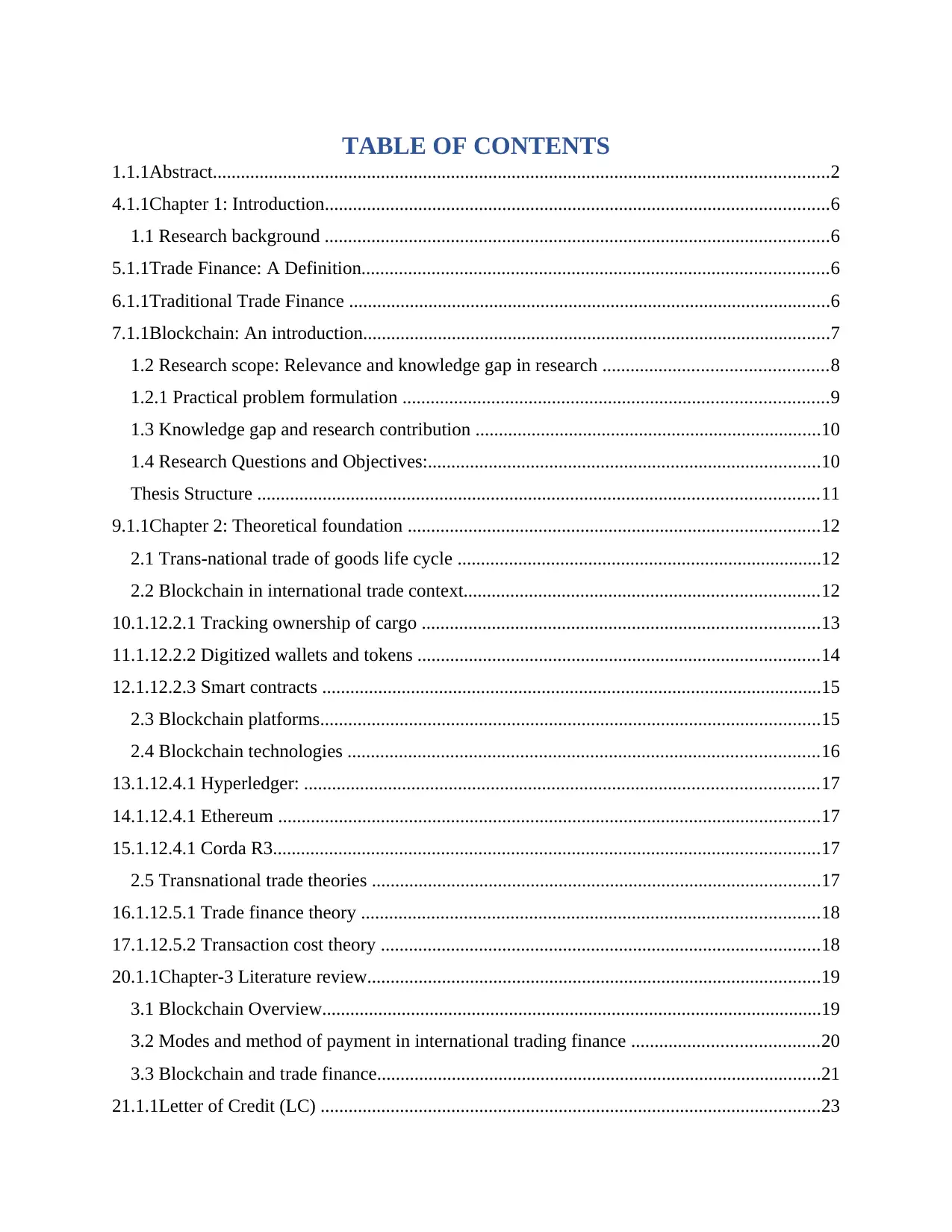
TABLE OF CONTENTS
1.1.1Abstract....................................................................................................................................2
4.1.1Chapter 1: Introduction............................................................................................................6
1.1 Research background ............................................................................................................6
5.1.1Trade Finance: A Definition....................................................................................................6
6.1.1Traditional Trade Finance .......................................................................................................6
7.1.1Blockchain: An introduction....................................................................................................7
1.2 Research scope: Relevance and knowledge gap in research ................................................8
1.2.1 Practical problem formulation ...........................................................................................9
1.3 Knowledge gap and research contribution ..........................................................................10
1.4 Research Questions and Objectives:....................................................................................10
Thesis Structure ........................................................................................................................11
9.1.1Chapter 2: Theoretical foundation ........................................................................................12
2.1 Trans-national trade of goods life cycle ..............................................................................12
2.2 Blockchain in international trade context............................................................................12
10.1.12.2.1 Tracking ownership of cargo .....................................................................................13
11.1.12.2.2 Digitized wallets and tokens ......................................................................................14
12.1.12.2.3 Smart contracts ...........................................................................................................15
2.3 Blockchain platforms...........................................................................................................15
2.4 Blockchain technologies .....................................................................................................16
13.1.12.4.1 Hyperledger: ..............................................................................................................17
14.1.12.4.1 Ethereum ....................................................................................................................17
15.1.12.4.1 Corda R3.....................................................................................................................17
2.5 Transnational trade theories ................................................................................................17
16.1.12.5.1 Trade finance theory ..................................................................................................18
17.1.12.5.2 Transaction cost theory ..............................................................................................18
20.1.1Chapter-3 Literature review.................................................................................................19
3.1 Blockchain Overview...........................................................................................................19
3.2 Modes and method of payment in international trading finance ........................................20
3.3 Blockchain and trade finance...............................................................................................21
21.1.1Letter of Credit (LC) ...........................................................................................................23
1.1.1Abstract....................................................................................................................................2
4.1.1Chapter 1: Introduction............................................................................................................6
1.1 Research background ............................................................................................................6
5.1.1Trade Finance: A Definition....................................................................................................6
6.1.1Traditional Trade Finance .......................................................................................................6
7.1.1Blockchain: An introduction....................................................................................................7
1.2 Research scope: Relevance and knowledge gap in research ................................................8
1.2.1 Practical problem formulation ...........................................................................................9
1.3 Knowledge gap and research contribution ..........................................................................10
1.4 Research Questions and Objectives:....................................................................................10
Thesis Structure ........................................................................................................................11
9.1.1Chapter 2: Theoretical foundation ........................................................................................12
2.1 Trans-national trade of goods life cycle ..............................................................................12
2.2 Blockchain in international trade context............................................................................12
10.1.12.2.1 Tracking ownership of cargo .....................................................................................13
11.1.12.2.2 Digitized wallets and tokens ......................................................................................14
12.1.12.2.3 Smart contracts ...........................................................................................................15
2.3 Blockchain platforms...........................................................................................................15
2.4 Blockchain technologies .....................................................................................................16
13.1.12.4.1 Hyperledger: ..............................................................................................................17
14.1.12.4.1 Ethereum ....................................................................................................................17
15.1.12.4.1 Corda R3.....................................................................................................................17
2.5 Transnational trade theories ................................................................................................17
16.1.12.5.1 Trade finance theory ..................................................................................................18
17.1.12.5.2 Transaction cost theory ..............................................................................................18
20.1.1Chapter-3 Literature review.................................................................................................19
3.1 Blockchain Overview...........................................................................................................19
3.2 Modes and method of payment in international trading finance ........................................20
3.3 Blockchain and trade finance...............................................................................................21
21.1.1Letter of Credit (LC) ...........................................................................................................23
Paraphrase This Document
Need a fresh take? Get an instant paraphrase of this document with our AI Paraphraser
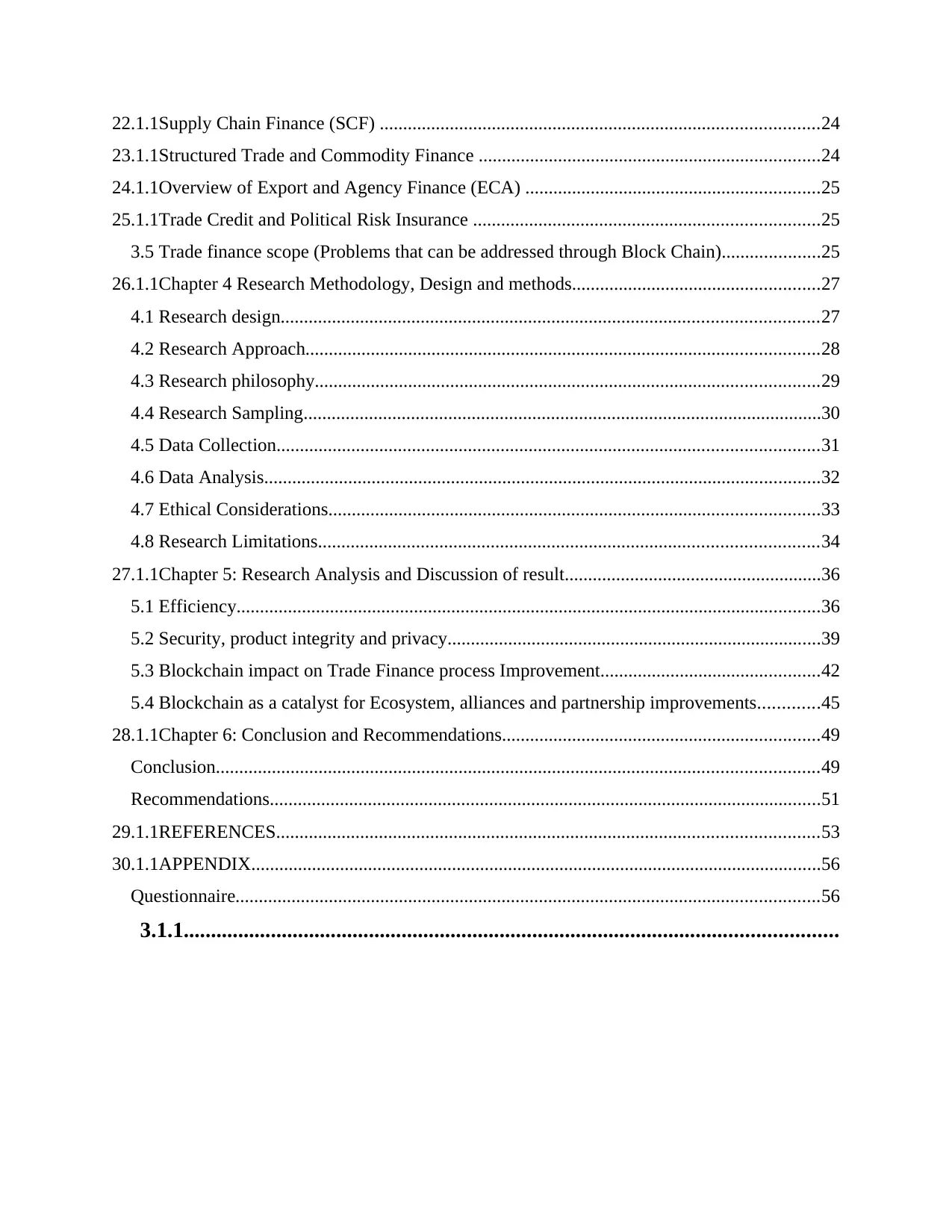
22.1.1Supply Chain Finance (SCF) ..............................................................................................24
23.1.1Structured Trade and Commodity Finance .........................................................................24
24.1.1Overview of Export and Agency Finance (ECA) ...............................................................25
25.1.1Trade Credit and Political Risk Insurance ..........................................................................25
3.5 Trade finance scope (Problems that can be addressed through Block Chain).....................25
26.1.1Chapter 4 Research Methodology, Design and methods.....................................................27
4.1 Research design...................................................................................................................27
4.2 Research Approach..............................................................................................................28
4.3 Research philosophy............................................................................................................29
4.4 Research Sampling...............................................................................................................30
4.5 Data Collection....................................................................................................................31
4.6 Data Analysis.......................................................................................................................32
4.7 Ethical Considerations.........................................................................................................33
4.8 Research Limitations...........................................................................................................34
27.1.1Chapter 5: Research Analysis and Discussion of result.......................................................36
5.1 Efficiency.............................................................................................................................36
5.2 Security, product integrity and privacy................................................................................39
5.3 Blockchain impact on Trade Finance process Improvement...............................................42
5.4 Blockchain as a catalyst for Ecosystem, alliances and partnership improvements.............45
28.1.1Chapter 6: Conclusion and Recommendations....................................................................49
Conclusion.................................................................................................................................49
Recommendations......................................................................................................................51
29.1.1REFERENCES....................................................................................................................53
30.1.1APPENDIX..........................................................................................................................56
Questionnaire.............................................................................................................................56
3.1.1........................................................................................................................
23.1.1Structured Trade and Commodity Finance .........................................................................24
24.1.1Overview of Export and Agency Finance (ECA) ...............................................................25
25.1.1Trade Credit and Political Risk Insurance ..........................................................................25
3.5 Trade finance scope (Problems that can be addressed through Block Chain).....................25
26.1.1Chapter 4 Research Methodology, Design and methods.....................................................27
4.1 Research design...................................................................................................................27
4.2 Research Approach..............................................................................................................28
4.3 Research philosophy............................................................................................................29
4.4 Research Sampling...............................................................................................................30
4.5 Data Collection....................................................................................................................31
4.6 Data Analysis.......................................................................................................................32
4.7 Ethical Considerations.........................................................................................................33
4.8 Research Limitations...........................................................................................................34
27.1.1Chapter 5: Research Analysis and Discussion of result.......................................................36
5.1 Efficiency.............................................................................................................................36
5.2 Security, product integrity and privacy................................................................................39
5.3 Blockchain impact on Trade Finance process Improvement...............................................42
5.4 Blockchain as a catalyst for Ecosystem, alliances and partnership improvements.............45
28.1.1Chapter 6: Conclusion and Recommendations....................................................................49
Conclusion.................................................................................................................................49
Recommendations......................................................................................................................51
29.1.1REFERENCES....................................................................................................................53
30.1.1APPENDIX..........................................................................................................................56
Questionnaire.............................................................................................................................56
3.1.1........................................................................................................................

4.1.1 Chapter 1: Introduction
1.1 Research background
Over the past decades, the global economy has been influenced by the rapid growth of
financial transactions that entail trillions of dollars (Hyvärinen, Risius & Friis, 2017). With the
stiff competition among business entities, financial institutions are no exception in adopting
various technologies to remain relevant in the market. New technologies such as blockchain have
positively impacted the operations in numerous business organizations especially on financial
operations in terms of records sharing, traceability and security of the transactions and other
documents related to international trade (Ishmaev, 2017). Delimatsis, (2018) identifies three
blockchain-based financial phases: an initiation phase that requires the client to access
blockchain network before buying or selling transaction; the verification stage of the financial set
in the blockchain ledger by various Stakeholders. The third stage is validation and storage. The
verified transactions in blockchain are performed and after validation they are stored in block.
The sealed blocks with hash or lock becomes part of the blockchain network and cannot be
modified. The proposed research aims to determine Blockchain's role and application in
improving and current processes in the International trade finance .
5.1.1 Trade Finance: A Definition
Trade finance is defined as a collective set of financial products and instruments firms use to
facilitate commerce and international trade. Trade finance actually makes it more convenient for
importers and exporters to conduct business using trade (Cong and He, 2019). Trade finance
covers many financial models and solutions that companies, and banking institutions use to make
the transactions for trade feasible. It involves numerous actors, including importers, exporters,
banks, carriers, customs officials, and insurers.
6.1.1 Traditional Trade Finance
Delayed exchange of information, unprecedented low trust levels, transparency and authenticity
conflicts associated with traditional trade finance systems are often considered as the prime
factors (Blossey, Eisenhardt and Hahn, 2019). This substantially contribute to unwarranted risk
and hinders the efficiency and profit margins in international trade business operations. The
1.1 Research background
Over the past decades, the global economy has been influenced by the rapid growth of
financial transactions that entail trillions of dollars (Hyvärinen, Risius & Friis, 2017). With the
stiff competition among business entities, financial institutions are no exception in adopting
various technologies to remain relevant in the market. New technologies such as blockchain have
positively impacted the operations in numerous business organizations especially on financial
operations in terms of records sharing, traceability and security of the transactions and other
documents related to international trade (Ishmaev, 2017). Delimatsis, (2018) identifies three
blockchain-based financial phases: an initiation phase that requires the client to access
blockchain network before buying or selling transaction; the verification stage of the financial set
in the blockchain ledger by various Stakeholders. The third stage is validation and storage. The
verified transactions in blockchain are performed and after validation they are stored in block.
The sealed blocks with hash or lock becomes part of the blockchain network and cannot be
modified. The proposed research aims to determine Blockchain's role and application in
improving and current processes in the International trade finance .
5.1.1 Trade Finance: A Definition
Trade finance is defined as a collective set of financial products and instruments firms use to
facilitate commerce and international trade. Trade finance actually makes it more convenient for
importers and exporters to conduct business using trade (Cong and He, 2019). Trade finance
covers many financial models and solutions that companies, and banking institutions use to make
the transactions for trade feasible. It involves numerous actors, including importers, exporters,
banks, carriers, customs officials, and insurers.
6.1.1 Traditional Trade Finance
Delayed exchange of information, unprecedented low trust levels, transparency and authenticity
conflicts associated with traditional trade finance systems are often considered as the prime
factors (Blossey, Eisenhardt and Hahn, 2019). This substantially contribute to unwarranted risk
and hinders the efficiency and profit margins in international trade business operations. The
⊘ This is a preview!⊘
Do you want full access?
Subscribe today to unlock all pages.

Trusted by 1+ million students worldwide
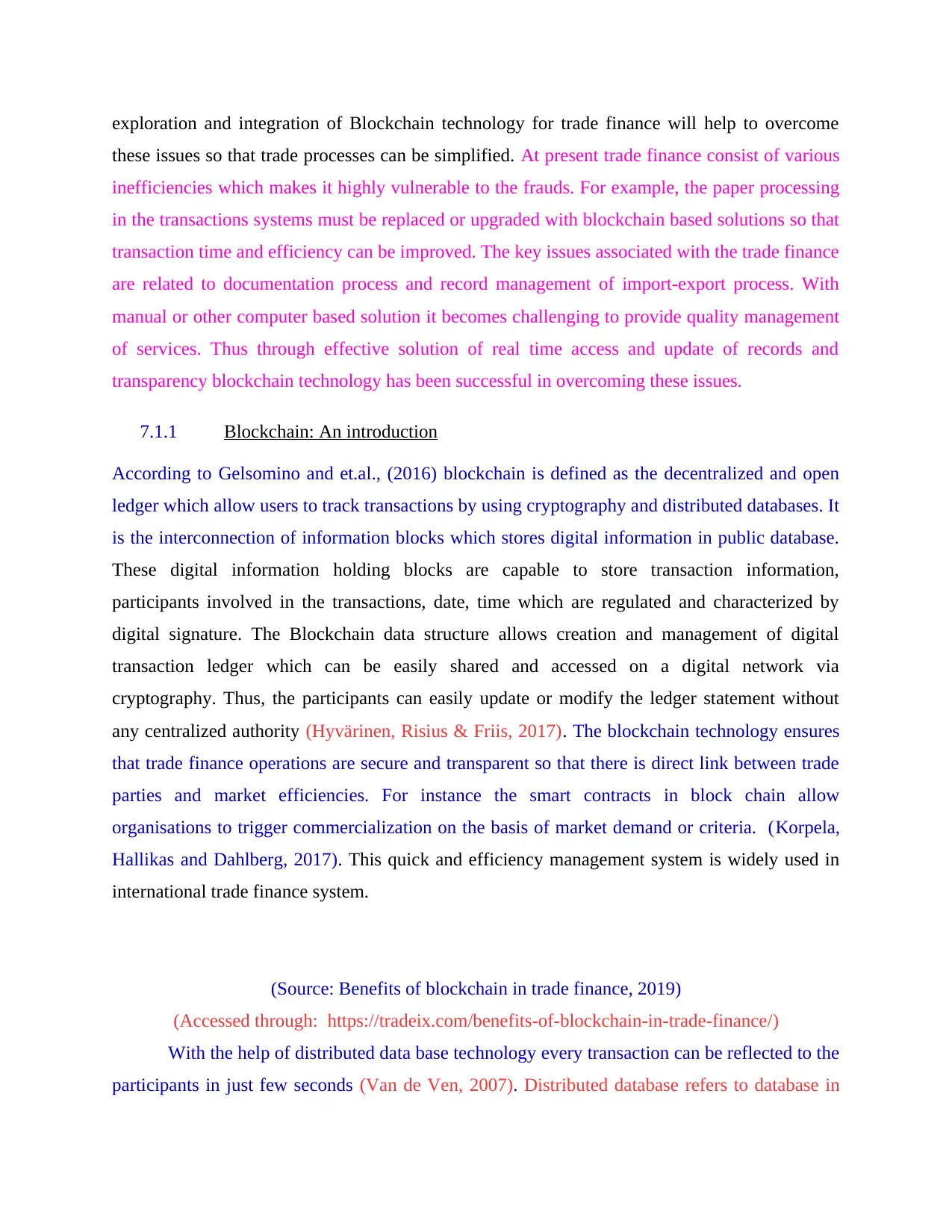
exploration and integration of Blockchain technology for trade finance will help to overcome
these issues so that trade processes can be simplified. At present trade finance consist of various
inefficiencies which makes it highly vulnerable to the frauds. For example, the paper processing
in the transactions systems must be replaced or upgraded with blockchain based solutions so that
transaction time and efficiency can be improved. The key issues associated with the trade finance
are related to documentation process and record management of import-export process. With
manual or other computer based solution it becomes challenging to provide quality management
of services. Thus through effective solution of real time access and update of records and
transparency blockchain technology has been successful in overcoming these issues.
7.1.1 Blockchain: An introduction
According to Gelsomino and et.al., (2016) blockchain is defined as the decentralized and open
ledger which allow users to track transactions by using cryptography and distributed databases. It
is the interconnection of information blocks which stores digital information in public database.
These digital information holding blocks are capable to store transaction information,
participants involved in the transactions, date, time which are regulated and characterized by
digital signature. The Blockchain data structure allows creation and management of digital
transaction ledger which can be easily shared and accessed on a digital network via
cryptography. Thus, the participants can easily update or modify the ledger statement without
any centralized authority (Hyvärinen, Risius & Friis, 2017). The blockchain technology ensures
that trade finance operations are secure and transparent so that there is direct link between trade
parties and market efficiencies. For instance the smart contracts in block chain allow
organisations to trigger commercialization on the basis of market demand or criteria. (Korpela,
Hallikas and Dahlberg, 2017). This quick and efficiency management system is widely used in
international trade finance system.
(Source: Benefits of blockchain in trade finance, 2019)
(Accessed through: https://tradeix.com/benefits-of-blockchain-in-trade-finance/)
With the help of distributed data base technology every transaction can be reflected to the
participants in just few seconds (Van de Ven, 2007). Distributed database refers to database in
these issues so that trade processes can be simplified. At present trade finance consist of various
inefficiencies which makes it highly vulnerable to the frauds. For example, the paper processing
in the transactions systems must be replaced or upgraded with blockchain based solutions so that
transaction time and efficiency can be improved. The key issues associated with the trade finance
are related to documentation process and record management of import-export process. With
manual or other computer based solution it becomes challenging to provide quality management
of services. Thus through effective solution of real time access and update of records and
transparency blockchain technology has been successful in overcoming these issues.
7.1.1 Blockchain: An introduction
According to Gelsomino and et.al., (2016) blockchain is defined as the decentralized and open
ledger which allow users to track transactions by using cryptography and distributed databases. It
is the interconnection of information blocks which stores digital information in public database.
These digital information holding blocks are capable to store transaction information,
participants involved in the transactions, date, time which are regulated and characterized by
digital signature. The Blockchain data structure allows creation and management of digital
transaction ledger which can be easily shared and accessed on a digital network via
cryptography. Thus, the participants can easily update or modify the ledger statement without
any centralized authority (Hyvärinen, Risius & Friis, 2017). The blockchain technology ensures
that trade finance operations are secure and transparent so that there is direct link between trade
parties and market efficiencies. For instance the smart contracts in block chain allow
organisations to trigger commercialization on the basis of market demand or criteria. (Korpela,
Hallikas and Dahlberg, 2017). This quick and efficiency management system is widely used in
international trade finance system.
(Source: Benefits of blockchain in trade finance, 2019)
(Accessed through: https://tradeix.com/benefits-of-blockchain-in-trade-finance/)
With the help of distributed data base technology every transaction can be reflected to the
participants in just few seconds (Van de Ven, 2007). Distributed database refers to database in
Paraphrase This Document
Need a fresh take? Get an instant paraphrase of this document with our AI Paraphraser
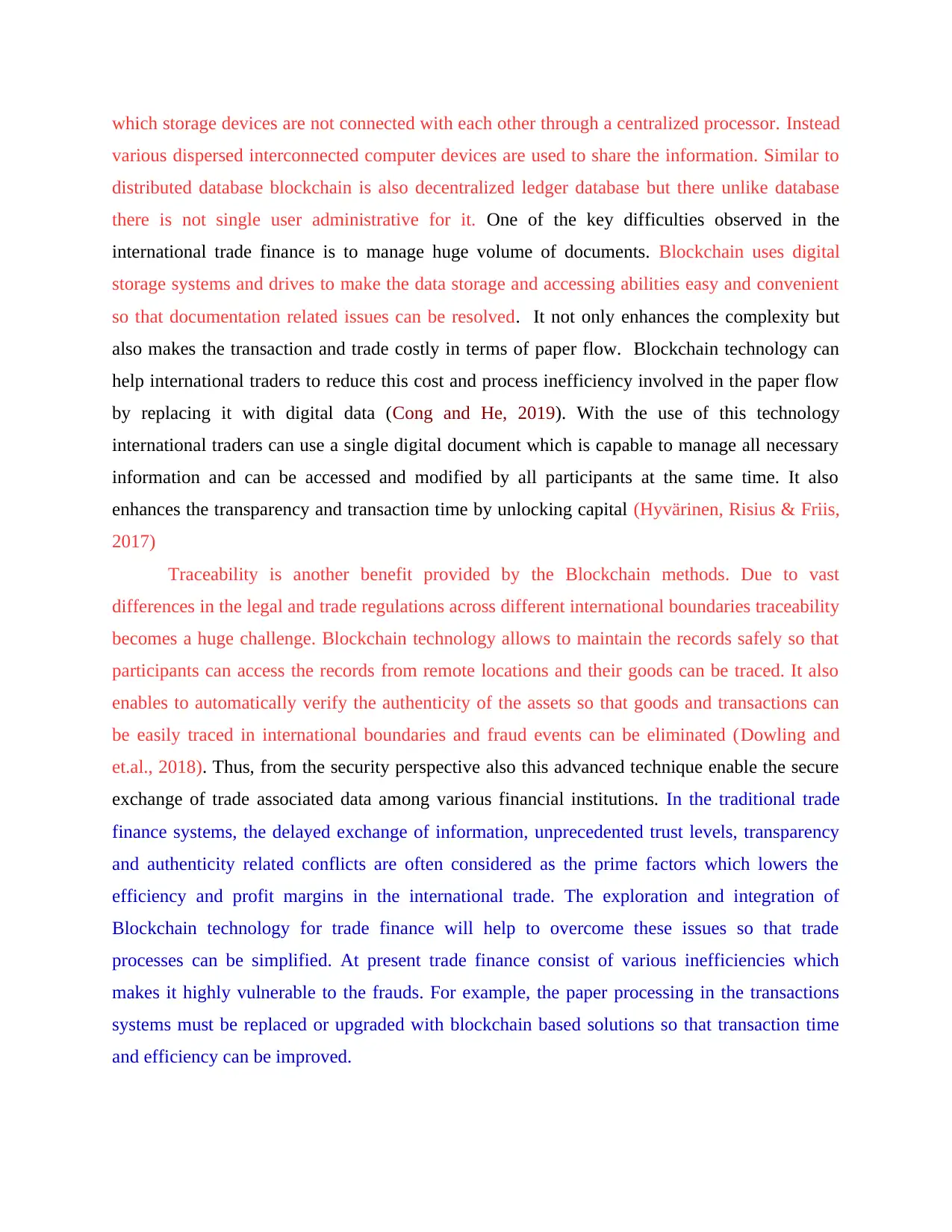
which storage devices are not connected with each other through a centralized processor. Instead
various dispersed interconnected computer devices are used to share the information. Similar to
distributed database blockchain is also decentralized ledger database but there unlike database
there is not single user administrative for it. One of the key difficulties observed in the
international trade finance is to manage huge volume of documents. Blockchain uses digital
storage systems and drives to make the data storage and accessing abilities easy and convenient
so that documentation related issues can be resolved. It not only enhances the complexity but
also makes the transaction and trade costly in terms of paper flow. Blockchain technology can
help international traders to reduce this cost and process inefficiency involved in the paper flow
by replacing it with digital data (Cong and He, 2019). With the use of this technology
international traders can use a single digital document which is capable to manage all necessary
information and can be accessed and modified by all participants at the same time. It also
enhances the transparency and transaction time by unlocking capital (Hyvärinen, Risius & Friis,
2017)
Traceability is another benefit provided by the Blockchain methods. Due to vast
differences in the legal and trade regulations across different international boundaries traceability
becomes a huge challenge. Blockchain technology allows to maintain the records safely so that
participants can access the records from remote locations and their goods can be traced. It also
enables to automatically verify the authenticity of the assets so that goods and transactions can
be easily traced in international boundaries and fraud events can be eliminated (Dowling and
et.al., 2018). Thus, from the security perspective also this advanced technique enable the secure
exchange of trade associated data among various financial institutions. In the traditional trade
finance systems, the delayed exchange of information, unprecedented trust levels, transparency
and authenticity related conflicts are often considered as the prime factors which lowers the
efficiency and profit margins in the international trade. The exploration and integration of
Blockchain technology for trade finance will help to overcome these issues so that trade
processes can be simplified. At present trade finance consist of various inefficiencies which
makes it highly vulnerable to the frauds. For example, the paper processing in the transactions
systems must be replaced or upgraded with blockchain based solutions so that transaction time
and efficiency can be improved.
various dispersed interconnected computer devices are used to share the information. Similar to
distributed database blockchain is also decentralized ledger database but there unlike database
there is not single user administrative for it. One of the key difficulties observed in the
international trade finance is to manage huge volume of documents. Blockchain uses digital
storage systems and drives to make the data storage and accessing abilities easy and convenient
so that documentation related issues can be resolved. It not only enhances the complexity but
also makes the transaction and trade costly in terms of paper flow. Blockchain technology can
help international traders to reduce this cost and process inefficiency involved in the paper flow
by replacing it with digital data (Cong and He, 2019). With the use of this technology
international traders can use a single digital document which is capable to manage all necessary
information and can be accessed and modified by all participants at the same time. It also
enhances the transparency and transaction time by unlocking capital (Hyvärinen, Risius & Friis,
2017)
Traceability is another benefit provided by the Blockchain methods. Due to vast
differences in the legal and trade regulations across different international boundaries traceability
becomes a huge challenge. Blockchain technology allows to maintain the records safely so that
participants can access the records from remote locations and their goods can be traced. It also
enables to automatically verify the authenticity of the assets so that goods and transactions can
be easily traced in international boundaries and fraud events can be eliminated (Dowling and
et.al., 2018). Thus, from the security perspective also this advanced technique enable the secure
exchange of trade associated data among various financial institutions. In the traditional trade
finance systems, the delayed exchange of information, unprecedented trust levels, transparency
and authenticity related conflicts are often considered as the prime factors which lowers the
efficiency and profit margins in the international trade. The exploration and integration of
Blockchain technology for trade finance will help to overcome these issues so that trade
processes can be simplified. At present trade finance consist of various inefficiencies which
makes it highly vulnerable to the frauds. For example, the paper processing in the transactions
systems must be replaced or upgraded with blockchain based solutions so that transaction time
and efficiency can be improved.
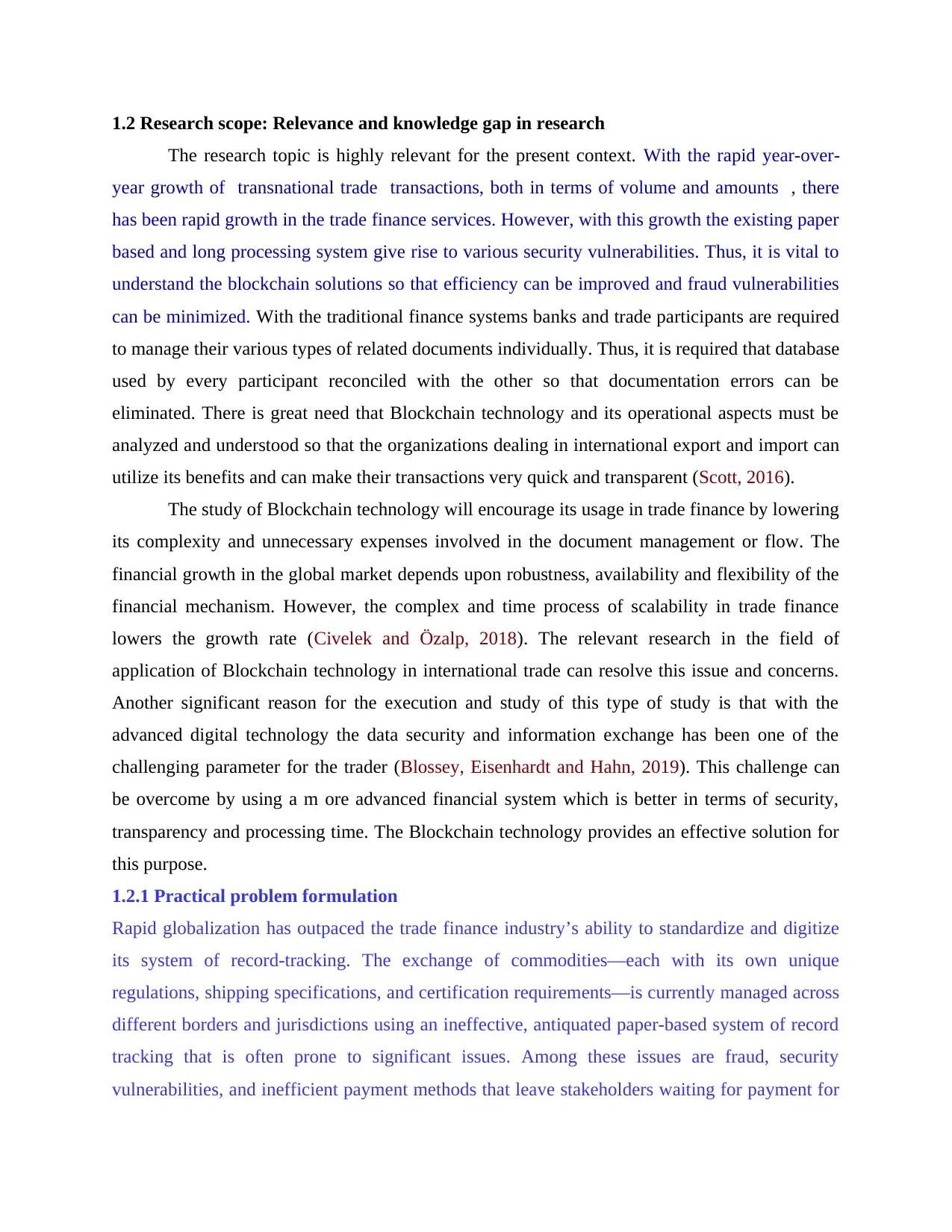
1.2 Research scope: Relevance and knowledge gap in research
The research topic is highly relevant for the present context. With the rapid year-over-
year growth of transnational trade transactions, both in terms of volume and amounts , there
has been rapid growth in the trade finance services. However, with this growth the existing paper
based and long processing system give rise to various security vulnerabilities. Thus, it is vital to
understand the blockchain solutions so that efficiency can be improved and fraud vulnerabilities
can be minimized. With the traditional finance systems banks and trade participants are required
to manage their various types of related documents individually. Thus, it is required that database
used by every participant reconciled with the other so that documentation errors can be
eliminated. There is great need that Blockchain technology and its operational aspects must be
analyzed and understood so that the organizations dealing in international export and import can
utilize its benefits and can make their transactions very quick and transparent (Scott, 2016).
The study of Blockchain technology will encourage its usage in trade finance by lowering
its complexity and unnecessary expenses involved in the document management or flow. The
financial growth in the global market depends upon robustness, availability and flexibility of the
financial mechanism. However, the complex and time process of scalability in trade finance
lowers the growth rate (Civelek and Özalp, 2018). The relevant research in the field of
application of Blockchain technology in international trade can resolve this issue and concerns.
Another significant reason for the execution and study of this type of study is that with the
advanced digital technology the data security and information exchange has been one of the
challenging parameter for the trader (Blossey, Eisenhardt and Hahn, 2019). This challenge can
be overcome by using a m ore advanced financial system which is better in terms of security,
transparency and processing time. The Blockchain technology provides an effective solution for
this purpose.
1.2.1 Practical problem formulation
Rapid globalization has outpaced the trade finance industry’s ability to standardize and digitize
its system of record-tracking. The exchange of commodities—each with its own unique
regulations, shipping specifications, and certification requirements—is currently managed across
different borders and jurisdictions using an ineffective, antiquated paper-based system of record
tracking that is often prone to significant issues. Among these issues are fraud, security
vulnerabilities, and inefficient payment methods that leave stakeholders waiting for payment for
The research topic is highly relevant for the present context. With the rapid year-over-
year growth of transnational trade transactions, both in terms of volume and amounts , there
has been rapid growth in the trade finance services. However, with this growth the existing paper
based and long processing system give rise to various security vulnerabilities. Thus, it is vital to
understand the blockchain solutions so that efficiency can be improved and fraud vulnerabilities
can be minimized. With the traditional finance systems banks and trade participants are required
to manage their various types of related documents individually. Thus, it is required that database
used by every participant reconciled with the other so that documentation errors can be
eliminated. There is great need that Blockchain technology and its operational aspects must be
analyzed and understood so that the organizations dealing in international export and import can
utilize its benefits and can make their transactions very quick and transparent (Scott, 2016).
The study of Blockchain technology will encourage its usage in trade finance by lowering
its complexity and unnecessary expenses involved in the document management or flow. The
financial growth in the global market depends upon robustness, availability and flexibility of the
financial mechanism. However, the complex and time process of scalability in trade finance
lowers the growth rate (Civelek and Özalp, 2018). The relevant research in the field of
application of Blockchain technology in international trade can resolve this issue and concerns.
Another significant reason for the execution and study of this type of study is that with the
advanced digital technology the data security and information exchange has been one of the
challenging parameter for the trader (Blossey, Eisenhardt and Hahn, 2019). This challenge can
be overcome by using a m ore advanced financial system which is better in terms of security,
transparency and processing time. The Blockchain technology provides an effective solution for
this purpose.
1.2.1 Practical problem formulation
Rapid globalization has outpaced the trade finance industry’s ability to standardize and digitize
its system of record-tracking. The exchange of commodities—each with its own unique
regulations, shipping specifications, and certification requirements—is currently managed across
different borders and jurisdictions using an ineffective, antiquated paper-based system of record
tracking that is often prone to significant issues. Among these issues are fraud, security
vulnerabilities, and inefficient payment methods that leave stakeholders waiting for payment for
⊘ This is a preview!⊘
Do you want full access?
Subscribe today to unlock all pages.

Trusted by 1+ million students worldwide
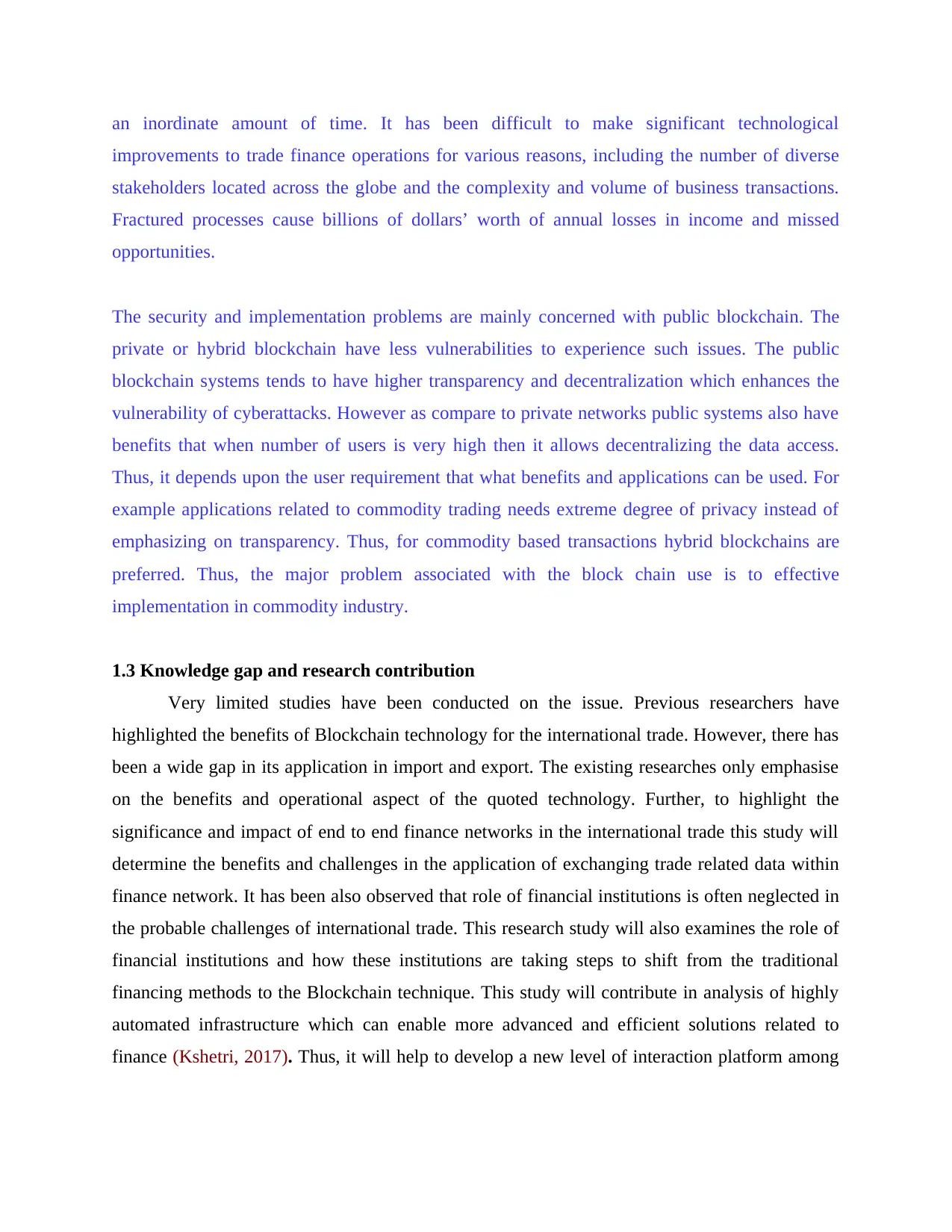
an inordinate amount of time. It has been difficult to make significant technological
improvements to trade finance operations for various reasons, including the number of diverse
stakeholders located across the globe and the complexity and volume of business transactions.
Fractured processes cause billions of dollars’ worth of annual losses in income and missed
opportunities.
The security and implementation problems are mainly concerned with public blockchain. The
private or hybrid blockchain have less vulnerabilities to experience such issues. The public
blockchain systems tends to have higher transparency and decentralization which enhances the
vulnerability of cyberattacks. However as compare to private networks public systems also have
benefits that when number of users is very high then it allows decentralizing the data access.
Thus, it depends upon the user requirement that what benefits and applications can be used. For
example applications related to commodity trading needs extreme degree of privacy instead of
emphasizing on transparency. Thus, for commodity based transactions hybrid blockchains are
preferred. Thus, the major problem associated with the block chain use is to effective
implementation in commodity industry.
1.3 Knowledge gap and research contribution
Very limited studies have been conducted on the issue. Previous researchers have
highlighted the benefits of Blockchain technology for the international trade. However, there has
been a wide gap in its application in import and export. The existing researches only emphasise
on the benefits and operational aspect of the quoted technology. Further, to highlight the
significance and impact of end to end finance networks in the international trade this study will
determine the benefits and challenges in the application of exchanging trade related data within
finance network. It has been also observed that role of financial institutions is often neglected in
the probable challenges of international trade. This research study will also examines the role of
financial institutions and how these institutions are taking steps to shift from the traditional
financing methods to the Blockchain technique. This study will contribute in analysis of highly
automated infrastructure which can enable more advanced and efficient solutions related to
finance (Kshetri, 2017). Thus, it will help to develop a new level of interaction platform among
improvements to trade finance operations for various reasons, including the number of diverse
stakeholders located across the globe and the complexity and volume of business transactions.
Fractured processes cause billions of dollars’ worth of annual losses in income and missed
opportunities.
The security and implementation problems are mainly concerned with public blockchain. The
private or hybrid blockchain have less vulnerabilities to experience such issues. The public
blockchain systems tends to have higher transparency and decentralization which enhances the
vulnerability of cyberattacks. However as compare to private networks public systems also have
benefits that when number of users is very high then it allows decentralizing the data access.
Thus, it depends upon the user requirement that what benefits and applications can be used. For
example applications related to commodity trading needs extreme degree of privacy instead of
emphasizing on transparency. Thus, for commodity based transactions hybrid blockchains are
preferred. Thus, the major problem associated with the block chain use is to effective
implementation in commodity industry.
1.3 Knowledge gap and research contribution
Very limited studies have been conducted on the issue. Previous researchers have
highlighted the benefits of Blockchain technology for the international trade. However, there has
been a wide gap in its application in import and export. The existing researches only emphasise
on the benefits and operational aspect of the quoted technology. Further, to highlight the
significance and impact of end to end finance networks in the international trade this study will
determine the benefits and challenges in the application of exchanging trade related data within
finance network. It has been also observed that role of financial institutions is often neglected in
the probable challenges of international trade. This research study will also examines the role of
financial institutions and how these institutions are taking steps to shift from the traditional
financing methods to the Blockchain technique. This study will contribute in analysis of highly
automated infrastructure which can enable more advanced and efficient solutions related to
finance (Kshetri, 2017). Thus, it will help to develop a new level of interaction platform among
Paraphrase This Document
Need a fresh take? Get an instant paraphrase of this document with our AI Paraphraser
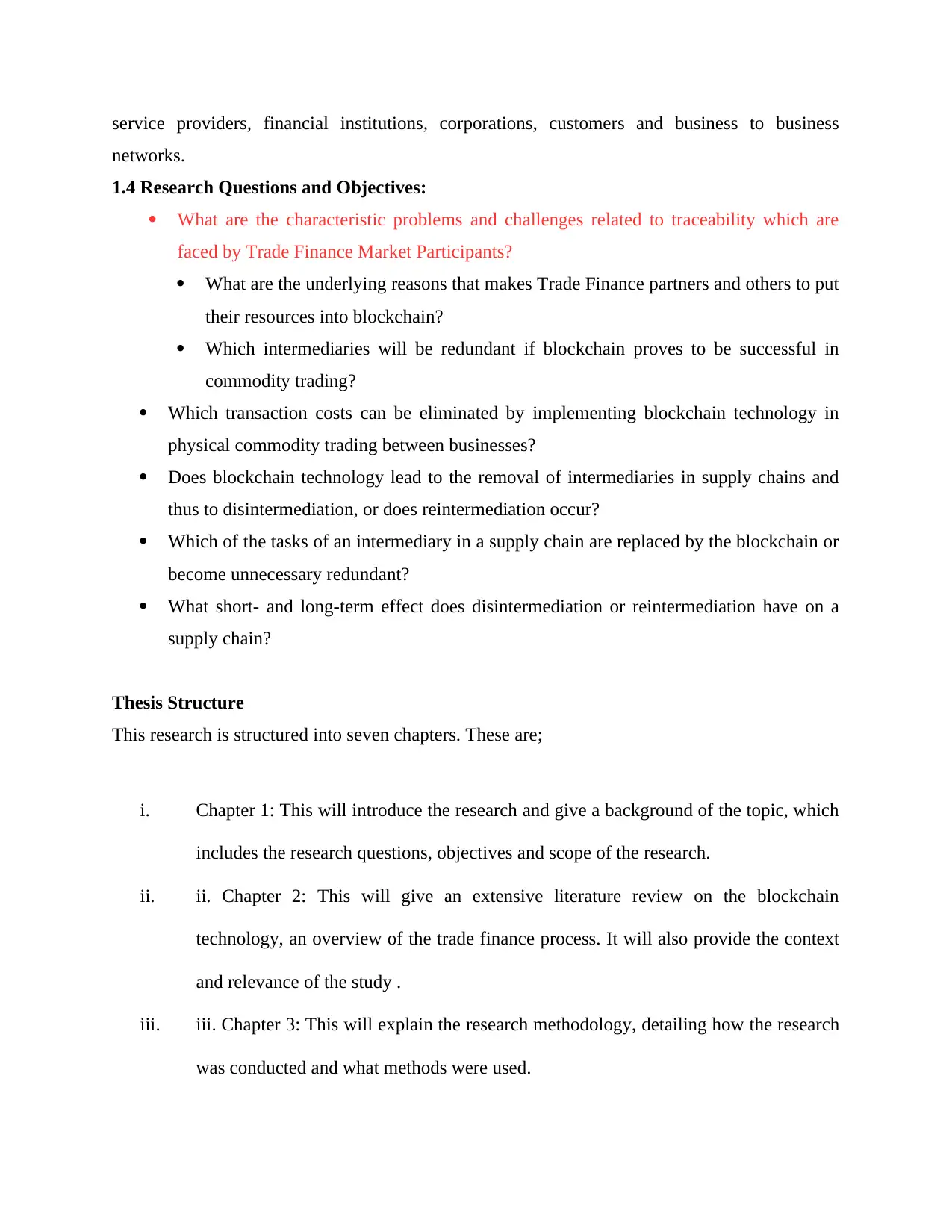
service providers, financial institutions, corporations, customers and business to business
networks.
1.4 Research Questions and Objectives:
What are the characteristic problems and challenges related to traceability which are
faced by Trade Finance Market Participants?
What are the underlying reasons that makes Trade Finance partners and others to put
their resources into blockchain?
Which intermediaries will be redundant if blockchain proves to be successful in
commodity trading?
Which transaction costs can be eliminated by implementing blockchain technology in
physical commodity trading between businesses?
Does blockchain technology lead to the removal of intermediaries in supply chains and
thus to disintermediation, or does reintermediation occur?
Which of the tasks of an intermediary in a supply chain are replaced by the blockchain or
become unnecessary redundant?
What short- and long-term effect does disintermediation or reintermediation have on a
supply chain?
Thesis Structure
This research is structured into seven chapters. These are;
i. Chapter 1: This will introduce the research and give a background of the topic, which
includes the research questions, objectives and scope of the research.
ii. ii. Chapter 2: This will give an extensive literature review on the blockchain
technology, an overview of the trade finance process. It will also provide the context
and relevance of the study .
iii. iii. Chapter 3: This will explain the research methodology, detailing how the research
was conducted and what methods were used.
networks.
1.4 Research Questions and Objectives:
What are the characteristic problems and challenges related to traceability which are
faced by Trade Finance Market Participants?
What are the underlying reasons that makes Trade Finance partners and others to put
their resources into blockchain?
Which intermediaries will be redundant if blockchain proves to be successful in
commodity trading?
Which transaction costs can be eliminated by implementing blockchain technology in
physical commodity trading between businesses?
Does blockchain technology lead to the removal of intermediaries in supply chains and
thus to disintermediation, or does reintermediation occur?
Which of the tasks of an intermediary in a supply chain are replaced by the blockchain or
become unnecessary redundant?
What short- and long-term effect does disintermediation or reintermediation have on a
supply chain?
Thesis Structure
This research is structured into seven chapters. These are;
i. Chapter 1: This will introduce the research and give a background of the topic, which
includes the research questions, objectives and scope of the research.
ii. ii. Chapter 2: This will give an extensive literature review on the blockchain
technology, an overview of the trade finance process. It will also provide the context
and relevance of the study .
iii. iii. Chapter 3: This will explain the research methodology, detailing how the research
was conducted and what methods were used.
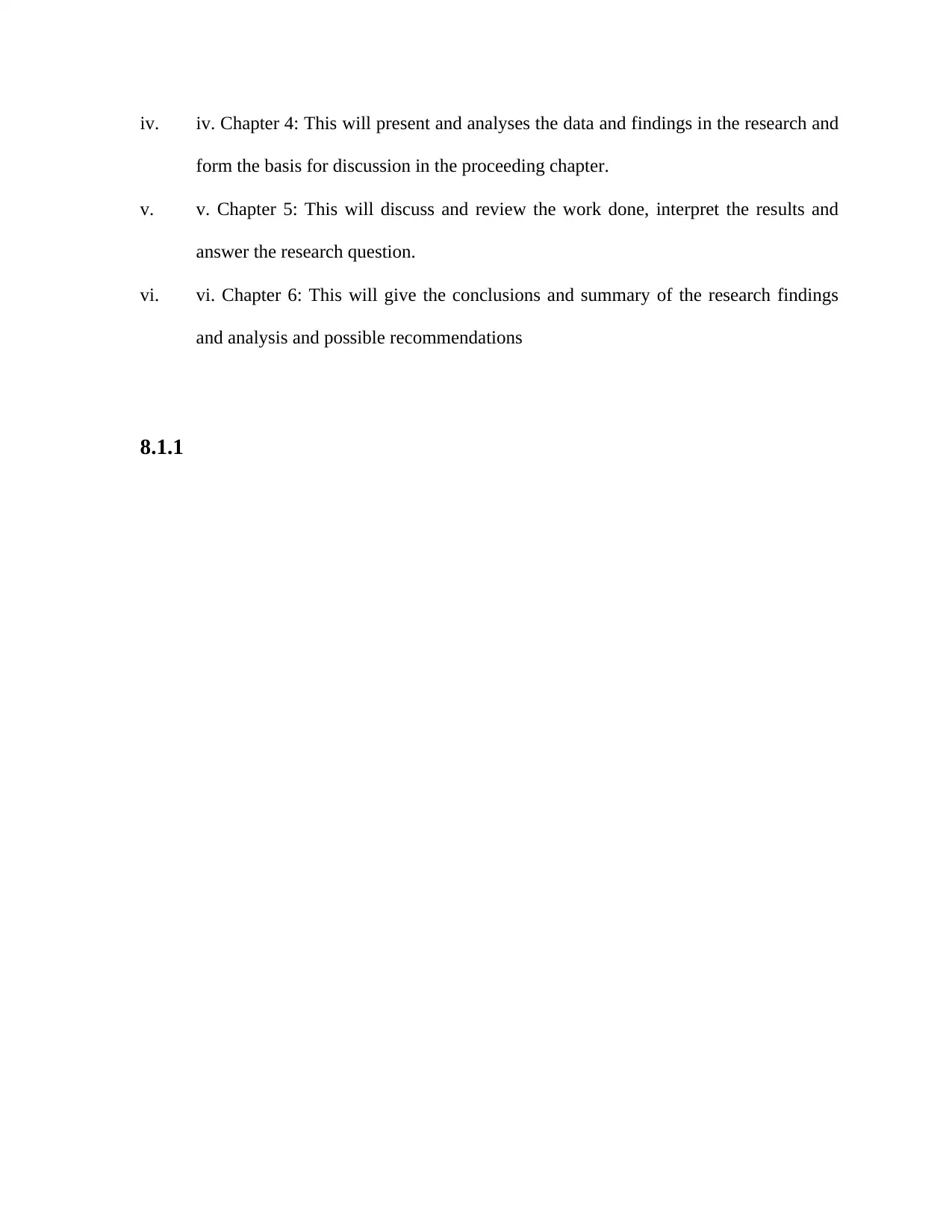
iv. iv. Chapter 4: This will present and analyses the data and findings in the research and
form the basis for discussion in the proceeding chapter.
v. v. Chapter 5: This will discuss and review the work done, interpret the results and
answer the research question.
vi. vi. Chapter 6: This will give the conclusions and summary of the research findings
and analysis and possible recommendations
8.1.1
form the basis for discussion in the proceeding chapter.
v. v. Chapter 5: This will discuss and review the work done, interpret the results and
answer the research question.
vi. vi. Chapter 6: This will give the conclusions and summary of the research findings
and analysis and possible recommendations
8.1.1
⊘ This is a preview!⊘
Do you want full access?
Subscribe today to unlock all pages.

Trusted by 1+ million students worldwide
1 out of 61
Related Documents
Your All-in-One AI-Powered Toolkit for Academic Success.
+13062052269
info@desklib.com
Available 24*7 on WhatsApp / Email
![[object Object]](/_next/static/media/star-bottom.7253800d.svg)
Unlock your academic potential
Copyright © 2020–2025 A2Z Services. All Rights Reserved. Developed and managed by ZUCOL.





